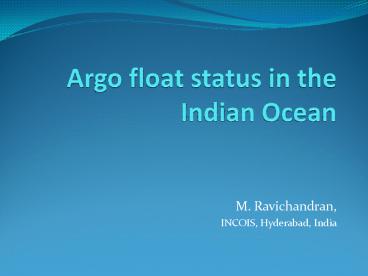Argo float status in the Indian Ocean - PowerPoint PPT Presentation
1 / 17
Title: Argo float status in the Indian Ocean
1
Argo float status in the Indian Ocean
- M. Ravichandran,
- INCOIS, Hyderabad, India
2
Pre
436 floats in North of 40 S
3
(No Transcript)
4
(No Transcript)
5
(No Transcript)
6
No of Floats/Year
7
Argo float information
Data download
8
(No Transcript)
9
Argo Users Workshop at INCOIS
- To know and understand
- What are the different applications using Argo
data in Indian Ocean? - What we have learned from Argo and what we need
to learn? - What are the efforts in assimilating Argo in
OGCM? - Whether spatial, temporal and vertical sampling
is adequate for such applications? - What are the products required for other
applications from argo? - Requirement of new parameters from Argo such as
Oxygen, chlorophyll, etc
July 20-22, 2008
10
Participating Institutions
- 63 Participants from 17 Institutions/University
- Andhra University, Vishakapatnam
- Cochin University of Science and Technology,
Kochi - Indian Institute of Technology, Delhi
- Indian Institute of Science, Bangalore
- Indian Institute of Tropical Meteorology, Pune
- Indian Navy
- INCOIS, Hyderabad
- Ministry of Earth Sciences, New Delhi
- Nansen Environmental Research Center, Kochi
- National Centre for Antarctic and Ocean Research,
Goa - National Centre for Medium Range Forecast, New
Delhi - National Institute of Oceanography, Goa
- National Remote Sensing Agency, Hyderabad.
- Naval Physical and Oceanographic Laboratory,
Kochi - Naval Operational Data Processing and Analysis
Center, Kochi - Space Application Centre, ISRO, Ahmedabad
- University of Hyderbad, Hyderbad
11
Sessions
- Inaugural session
- Status of Argo project (Global India)
- Indian Ocean Process studies
- Indian Ocean dynamics and validation of models
- New sensor requirement
- Indian Ocean Dipole and Monsoon
26 contributed paper 5 Invited talks
12
Invited talk
- Role of Argo data in monitoring climate change
together with Coupled climate models Prof. J.
Srininivasan, IISc - Broad features of the Indian Ocean dynamics and
thermodynamics, and some of the outstanding
challenging problems Dr. R R Rao, NPOL - The historical measurements of salinity in the
Indian Ocean Dr. S. R. Shetye, NIO - Development of Argo floats since 1950 interms of
Technology - Prof. Stephen Riser, UW, USA - Air-sea interaction over Indian Ocean with
special emphasis on Indian Ocean dipole Prof.
B. N. Goswami, IITM
13
Indian Ocean process studies
- Buoyancy flux changes in the Bay of Bengal
- Upper ocean response of T S to local
atmospheric forcing - Mixed layer variability in Arabian Sea
- Delineating upwelling zones,
- Role salinity in thermal inversion in Arabian sea
- Validation of sonic layer depth
- Contribution of halo-steric height in dynamic
height - ..
14
Indian Ocean dynamics and validation of models
- Impact of summer monsoon ISO in tropical Indian
ocean using Argo and OGCM - Surface currents from Argo, altimeter and
scatterometer - Validation of OGCM using Argo observations
- Analysed Ocean state using Argo and OGCM
15
Indian Ocean dipole and monsoon
- Generation and termination of IOD mechanism
- Impact of IOD on SSS revealed from Argo,
- Role of subsurface Temp anomalies in the SW
Indian Ocean during 2006 dipole event - Indian Oean Monsoon interactions and drought
over India in relation to Indian ocean
sub-surface features
16
Recommendations Suggestions
- Argo data has been widely utilized to understand
the Indian Ocean dynamics, especially Dipole
event, understanding the monsoon system in
relation to heat content, buoyancy flux of the
Indian Ocean and for validation of OGCM. - Studies need to be initiated to assimilate Argo
floats in OGCM - In the Bay of Bengal, Argo floats with 5 days
cycling period need to be deployed. These
observations are to be sustained over a long
period by deploying new floats as and when
required. These observations are required for
studying the intra-seasonal variations of
thermo-haline structure. - New Iridium floats with an additional
high-resolution CTD are to be deployed in the Bay
of Bengal. This additional CTD sensors measures
P, T, S at very fine resolution (2 m) from 200 m
upto the surface. - Quality control methods followed by various
institutions need to be pooled. All such
Institutes to provide feedback on quality of data
to INCOIS.
17
- Thank you for your kind attention































